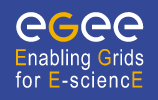
FAQ4
- What sort of training will EGEE offer users?
As part of the project, a Training and Induction Activity will produce a portfolio of training material and courses written in English, from introductory to advanced level.
This training will be supported at a regional level, and key material may be translated into the appropriate European languages for that region. The main types of training courses are:
- Induction courses (2 days, at least 10/year)
- Application developer training (4 days, at least 8/year)
- Advanced courses (5 days, at least 2/year)
- Retreats dedicated to specific technical activity areas (2 days, at least 6/year)
- How can users keep up to date about the development of EGEE?
A Dissemination and Outreach Activity (known as NA2) within the project is maintaining a one-stop-shop for all major project information. This website forms part of the Dissemination process and has a number of useful links to relevant websites.
In addition, focused email distribution lists will target key user and potential user groups, and there will be several major EGEE networking events to which all interested scientists and representatives from industry will be encouraged to attend. These networking events will include two annual conferences and a number training seminars.
- What are the benefits of contributing resources to EGEE?
Resource providers will perceive several advantages to joining EGEE:
- Large scale operations - Through EGEE a coordinated large scale operational setup is created. This will lead to significant cost savings and at the same time improved level of service provided at each participating resource partner.
- Specialist competence - By distributing service tasks among the partners EGEE will make use of the leading specialists in Europe to build and support the infrastructure.
- User contacts - The EGEE distributed support model will allow for regional adaptation and close contacts with regional user communities.
- Collaborations among resource partners - partners within EGEE may form collaborations and launch development and support actions not included in the present proposal. This will lead to cost sharing of R&D efforts among partners.
- How do I create a new Virtual Organization (VO)?
There are two key steps if you want to set up a new VO.
- Check to see if your experiment/group is already covered by an existing VO.
- Contact and OAG coordinators.
You will also be expected to be able to fulfil the following requirements;
- A VO membership server (VOMS).
- At least one resource center which accepts the VO.
- Access to a resource broker.
- Access to a file catalog.
- How do I incorporate my resources into the grid?
The steps for creating a site in the EGEE infrastructure are documented at the links below.
http://public.eu-egee.org/join/
The overall process is handled by the Regional Operation Centres (ROCs).
- How do I negotiate for more resources?
The OAG helps negotiate for having more resources made available for a VO.
The process involves answering a questionnaire and going through an interview to understand in detail the needs of the applications. The results are circulated to the ROCs and sites volunteer to support the application. This process normally forms part of the MoU process.
- How do I port my application to the grid?
The first stop should be the team for information.
You can also visit the for more information and even try out the grid.
For information on Biomedical applications take a look at the
is a project to coordinate the different activities that are needed to prototype distributed analysis systems for the LHC experiments using a grid.
The mandate of the Experiment integration support Team is to help the experiments in integrating their software with the LCG middleware and in understanding the functionalities, and to provide support during the integration and testing process.
- How do I make my application available via a portal?
The first step is to talk with the developers. There are also some other portals deployed in biomedical community.
- How do I incorporate a new service in the grid?
The architecture of the middleware is service-oriented. In general there is no problem with contacting VO-specific services from jobs on the grid. If the new service must interact with existing services, it is best to contact the middleware developers () about how to achieve this. VO-services at the site-level are very contentious and not advised.
- How do the developers know about my requirements?
Review the existing requirements in the requirements database:
Ask the coordinators for write-access to the database to add new requirements.
- Who do I contact if my jobs fail?
The system is the main user support framework.
You can also contact them via email as well using the following format:
MyVO-user-support@ggus.org (MyVO=atlas, biomed, ...)
or at
- Where can I see the resource consumption of my VO?
The APEL accounting system keeps track of resource utilisation on the grid. Summaries of the usage can be found on the accounting site:
- Where can I see the state of the grid?
Check out the monitoring systems available at the URL:
The GridPP monitoring page is a graphical representation of the EGEE Grid Infrastructure created by Imperial College in London. Click the link "(original jobs on the LCG) Real Time Monitor", then click the dots for more information about the node.
N.B. You will need Java installed to view the page.
Where can I see the state of the grid?
The contains various views grid status and grid information.
Latest News
The Call for Abstracts of the 3rd EGEE User Forum opened on 22 October 2007
... Read moreTechnical sites
Try the GRID
Become a User
Related Projects
Information Sheets
Contact EGEE
If you have questions about the Website contact: .

